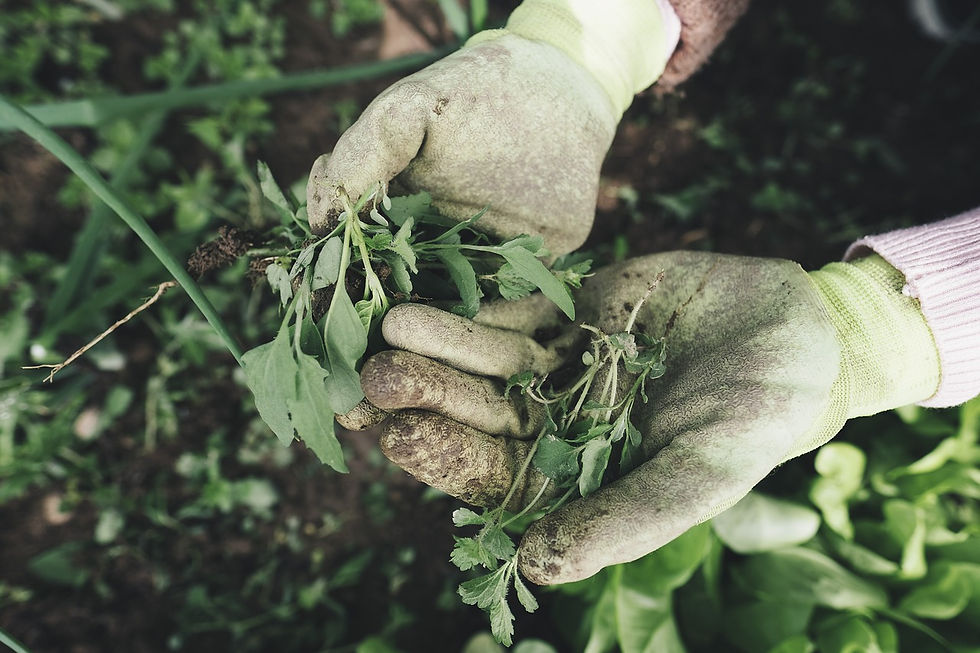7 Essential Spring Gardening Tips
- Eric Durnford
- Apr 10, 2020
- 4 min read
Updated: Oct 17, 2024
Warm weather is sneaking up quickly and our gardens are begging for attention. Preparing your garden now will save you extra labour in the summer. It’s time to dig out your favourite pair of gloves and get back in the dirt.
Here are 7 essential tips to get you started with your garden this spring. Your flowers and vegetables will thank you for it later!
1. Conduct Spring Inspection and Fix Your Hardscape

Time to get out your detective hat and see what damage the winter has brought.
Keep an eye out for frost or ice damage on plants.
Garden beds to be cleaned out, hardscaping like retaining walls that have shifted.
Evidence of new animal burrows from rabbits, skunks, chipmunks, etc.
If you have hardscaping elements in the garden, chances are that snow and ice may have heaved any stonework slightly out of place. Re-position, repair, or replace any hardscaping elements now while your plants are still safe and dormant.
You should prepare any trellises or stakes you have to support your plants. Give them a new coat of paint if needed. It’s easier to set them up in the spring than the summer when your plants have flowered.
2. Tune Up Tools

Take an inventory of your garden tools such as rakes, shovels and especially pruners to determine if any maintenance is required. Your garden tools may need some attention if they weren’t stored properly over the winter.
If rust has accumulated, remove by lightly sanding it and then disinfect it with 70% isopropyl alcohol.
Plant diseases can be transferred through the use of unwashed garden tools. Simply dip the cutting edges of your pruners in a small bowl of rubbing alcohol and wipe off with a clean cloth.
3. Remove Weeds, Dead Plants and Debris


It’s important to clean out the garden sooner than later as you don’t want to be stepping on plants as they’re emerging. Remove all debris, fallen plant material, and weeds to allow for new growth. You can cut back the dead growth on perennials and grasses at this point.
Most of your decayed plant material can be thrown back into your compost bin.
Make sure not to compost any weeds or diseased plants - keep them in a separate bin or burn them.
4. Divide Perennials and Transplant Shrubs

If you have not done so in the fall, some perennials will need to be divided to help them continue growing and stay healthy. These include:
Day lilies
Hostas
Ornamental grasses
Black eyed Susan, and more.
Overcrowded perennials compete for oxygen, water and nutrients. Dividing them will reduce competition, stimulate new growth as well as more lively blooms. Use the divided plants to expand your garden or give them to a gardening friend in need.
Transplant shrubs in the early spring while they are still dormant because it will be less stressful on the plant. Doing it early in the spring will allow them to quickly bounce back into action.
5. Re-Energize and Fertilize your Soil

Your soil will slowly deplete itself of nutrients as the plants absorb and use them. Spring is the best time to add some life and structure to your soil so your plants can thrive.
If you’ve been collecting compost, now is the perfect time to add it to your garden. If you’re planning on amending your soil, spread 1-2 inches of compost onto your soil and lightly till it in. If you’re just spreading some on your top soil, add about ¼ to a ½ inch.
You do not want your soil to be more than 50% compost.
Microbial-based organic fertilizers such as Nurture Growth biofertilizer can be used on its own or in tandem with compost as it can be used for soil amendment and will improve your soil over time.
Nurture Growth is 100% certified organic, eco friendly and is safe to use around children and pets.
6. Plan out your Garden

To ensure that you have a gorgeous blooming garden or an abundant vegetable garden, it is important to have a game plan. Many gardeners have a checklist while others keep a journal to help them stay organized and track their tasks.
Consult with your local nursery or the Old Farmer’s Almanac to see the best time to plant.
Cool season vegetables such as carrots, peas, spinach, lettuce, broccoli, cauliflower, cabbages and other greens will need to be planted in the early spring.
Remember to plant according to height to ensure your shorter ones have enough sunlight.
7. Don't Forget to Mulch!

Mulching is a great way to finish preparing your garden for the spring and giving added protection to your plants. Don’t spread mulch on top of seedlings that are waiting to sprout. Spread a thick layer of mulch, approximately 2-4 inches, wherever you can in your garden. Mulching is more effective when you can spread it before weeds have emerged. Mulch will also help retain water in your soil, mitigate soil temperatures, and provide physical protection in the winter.
We hope that you found this blog helpful. If you would like to share your tips, please contact us at info@nurturegrowthbio.com.
Blogger Biography

Eric is a gradate of the Environmental Science program at the University of Toronto. Coming from the green roof and landscaping industries, he does not hesitate to get his hands in the soil. He is actively searching for new ways to learn about our agricultural systems and get involved with his local agricultural community. Eric is an avid birdwatcher and advocate for environmental responsibility.



















Comentarios